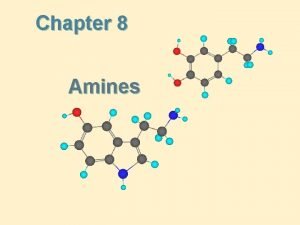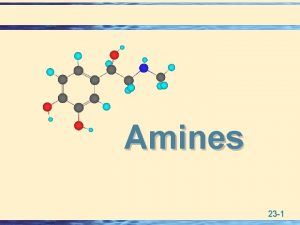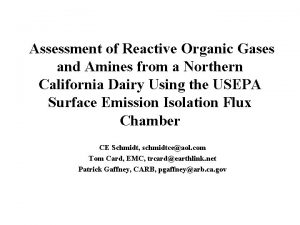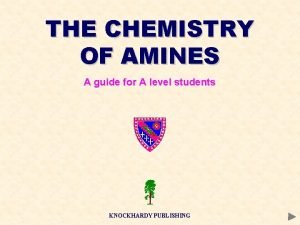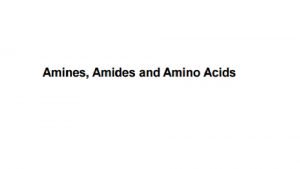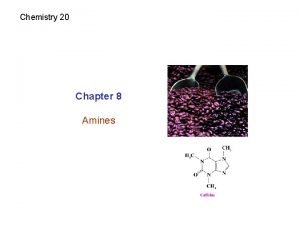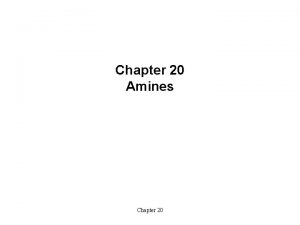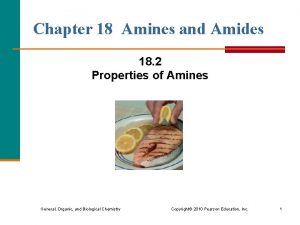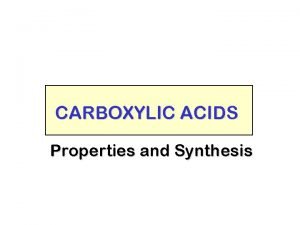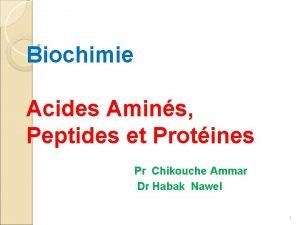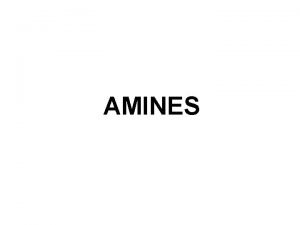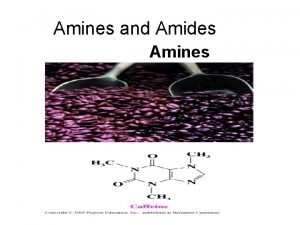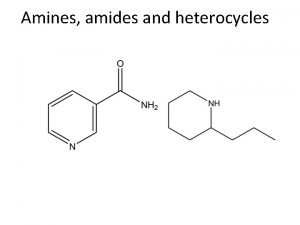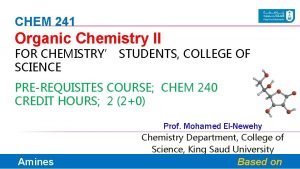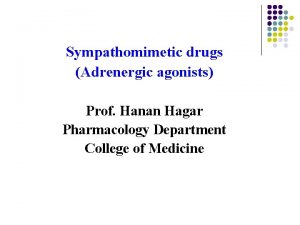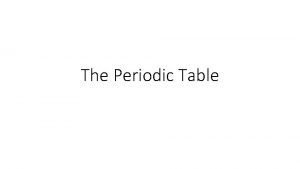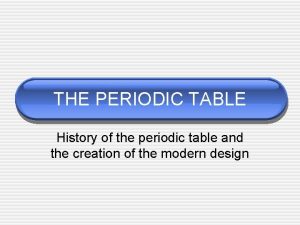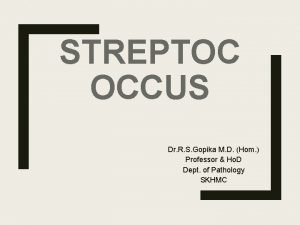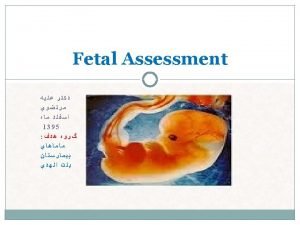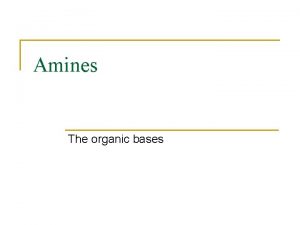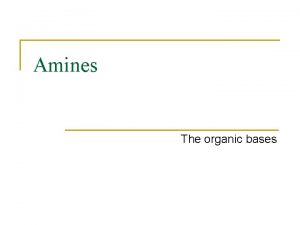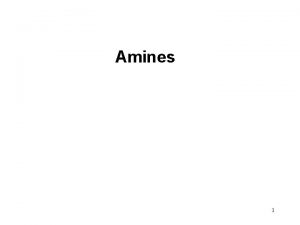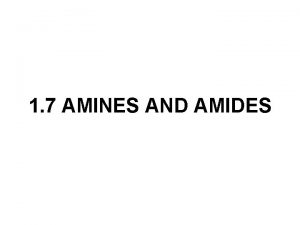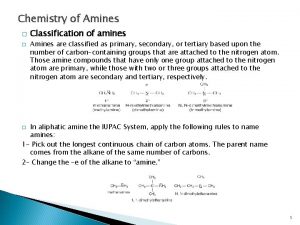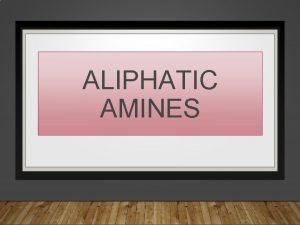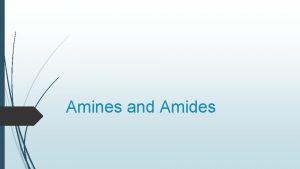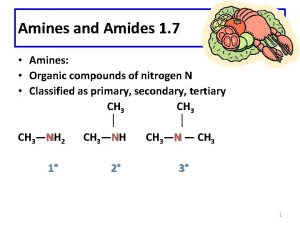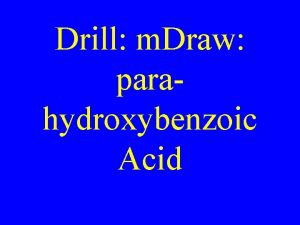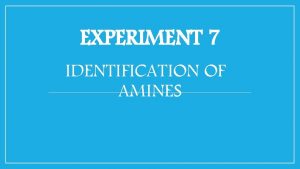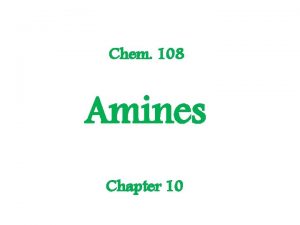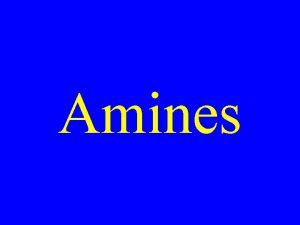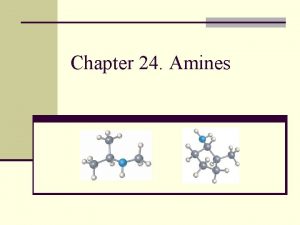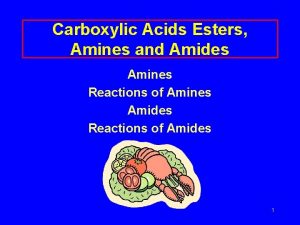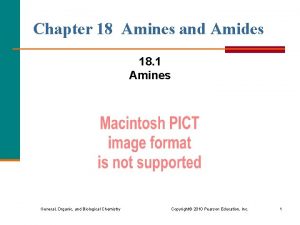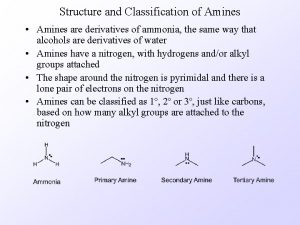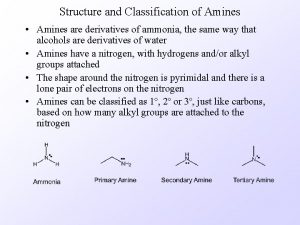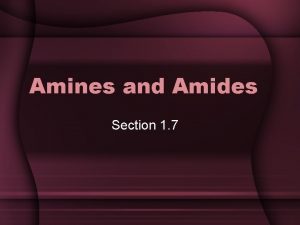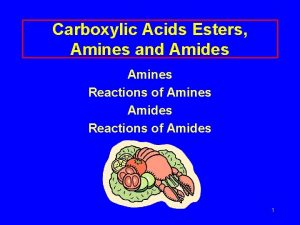Assessment of Reactive Organic Gases and Amines from




































- Slides: 36

Assessment of Reactive Organic Gases and Amines from a Northern California Dairy Using the USEPA Surface Emission Isolation Flux Chamber CE Schmidt, schmidtce@aol. com Tom Card, EMC, trcard@earthlink. net Patrick Gaffney, CARB, pgaffney@arb. ca. gov

Purpose of the Discussion • Present the USEPA flux chamber technology and the application for assessing air emissions from dairies • Describe the ARB/SJV multi-phase research project and the results of the Phase 2 summer testing event (process flux, dairy emissions, pounds/cow/year)

Project Authority • Co-Funded by ARB and SJVUAPCD • Sponsored by the Central CA Ozone Study • Work coordinated with other projects by the San Joaquin Valley Ag Tech Group • Project Management by Patrick Gaffney, ARB • Emission factors supporting SIPs/SB 700

Project Scope of Work • Developed a Site specific QAPP (Phase 1) • Conducted a two-day field test (Phase 2) at the Merced dairy • Over 40 flux chamber measurements were made at 11 types of emitting surfaces at a flushed lane dairy • Analysis included speciated reactive organic gases, ammonia/amines, total organic compounds, and methane • Empirical model developed to estimate emissions

Analytical Menu • USEPA Method TO-15 (GC/MS) for VOCs, ROG (expressed as methane and hexane) • NIOSH 2010 (IC) for ammonia and amines • ASTM 1945 (GC/TCD) for methane • USEPA Method TO-5 (HPLC/UV) for aldehydes/ketones • USEPA Method TO-5 (HPLC/UV) for volatile organic acids

Dairy Unit Processes (sources) • • • Flushed lanes: pre and post-flushed Solids storage piles* Lagoon* (inlet and outlet of lagoon) Solids in Solids separator* Bedding in pile for freestall* Freestall area

Dairy Unit Processes (continued) • • • Barn turnout and corral area* Manure piles in turnout* Heifer pens (dry cow area)* Open feed storage (in barn feed lanes) Milk parlor (wastewater effluent stream)* Note- Process in sun* tested for diurnal emissions


What’s A Flux Chamber? • A flux chamber is a device used for measuring the flux of gas species from an area source • There a variety of ‘flux chambers’, static and dynamic • USEPA Recommended Technology, mixed tank reactor operated at atmospheric pressure



Four Groups of Area Source Assessment Technologies • • Direct Measurement Indirect Measurement Predictive Modeling Fence line Measurement and Dispersion Modeling

Direct Measurement Technologies • Flux or emissions are measured, not determined by modeling • Screening-level: soil gas, static headspace sample, static headspace chamber • In-Depth Level: flux chamber, wind tunnel

So Why Use The Flux Chamber Technology Over the Others? • Assessment does not involve predictive modeling • All parameters of the measurement technology are controlled an estimate of accuracy/precision is made per application • Most cost-effective assessment technology • Can differentiate between sources of emissions at a complex-source facility

Theory of Operation • • • Mixed tank reactor- CSTR Clean sweep air is added to the chamber Chamber is operated for 5 residence times Chamber contents come to equilibrium Gas sample is collected for study compounds (grab or integrated sample collection) • Flux is calculated knowing sweep air flow rate, surface area, and concentration

Goal of the Assessment Using the Flux Chamber • Measure the compound (or odor) flux from the area source without disturbing the flux and without predictive modeling • Provide a data set that represents the area source emissions (flux times surface area is emissions in mass/time) • Report the range, average, and maximum compound flux as a function of the area source (i. e. , spatial, process, chemical/physical source changes as a function of time)

Advantages of Using the Direct Measurement/Flux Chamber • Only EPA recommended in-depth assessment technology applicable for most area sources • Known accuracy and precision • Very low sensitivity using appropriate sample collection and analysis • Spatially specific technology; defines unique emission sources • Can differentiate the sources of ubiquitous compounds • Provides the preferred input for dispersion assessment and compliance reporting












Dairy Emissions- Phase 2 Summer Emissions Compounds Sorted by Compound Mass Component (Continued) Lbs/cow/year Ammonia 245 Ethylamine 0. 90 Component Lbs/cow/year 1, 2 -Dibromo-3 chloropropane 0. 076 Naphthalene 0. 061 Methane 283 Carbon disulfide 0. 056 TNMHC as Hexane 3. 6 Acetaldehyde 0. 049 TNMHC as Methane 19. 4 Vinyl acetate 0. 038 2 -propanol 0. 033 Ethanol 1. 338 1, 4 Dioxane 0. 032 2 -Butanone 0. 288 t-1, 4 -Dichloro-2 -butene 0. 031 Acetone 0. 277 m & p-Xylene 0. 030 Acetone 0. 225 Isobutyl alcohol 0. 024 1, 2, 4 -Trichlorobenzene 0. 169 1, 2 -Dichlorobenzene 0. 024 Cyclohexane 0. 132 Toluene 0. 023

Preliminary Phase 2 ROG Results • Schmidt: 3. 6 lbs to 19 lbs ROG/cow/year based on flux chamber measurement • Current Emission Factors: 12. 8 lbs ROG/cow/head base on 1938 chamber study • Region 9 EPA: 5. 2 lbs ROG/cow/year based on flux chamber measurement

Preliminary Phase 2 NH 3 Results • Schmidt: 245 lbs NH 3/cow/year based on summer flux chamber measurement at one dairy • SCAQMD: 18 lbs NH 3/cow/year based on winter/summer flux chamber measurement at two dairies (dry lot dairies)

Literature Dairy NH 3 EFs Low High Source Lb/cow/yr NOAA 1999 50. 38 Pinder et al 28. 82 122. 1 Sutton et al 1995 48 72 Corsi 2000 43 101 USEPA 2001 51 USEPA 2002 55 EEA 2001 54. 2 Groot Koerkup 1998 Dutch Ag 9. 1 26. 8 9. 5 24. 2 Pedersen et al 2004 15. 3 Max is 122 lb/cow/yr; Min is 9. 1 lb/cow/yr Average is 46, st. dev. 34

Gross Conclusions • Barn feed source dominates ROG process emissions • The dominate ROG species is ethanol • Ammonia is the dominate amine • Freshly scraped turnouts dominate ammonia emissions • ROG and ammonia emissions relatively low from the wastewater lagoon

Summary • Process specific flux and emission estimates for a representative Northern California dairy were generated for total and speciated ROG speciated emissions • Facility-wide emissions were calculated • Estimate of ROG (total), ROG species, and amine species per cow emission factors were generated

Future Research • Phase 3 research may include: – Option A: More testing at the same dairy to evaluate seasonal emissions at significant sources (winter season) – Option B: Testing at a different dairy to evaluate dairy-to-dairy variability – Approach Modifications: lab method for VOAs, diurnal testing, focus on major sources, operations and facility utilization consideration

 Amines chemsheets
Amines chemsheets Aliphatic amines and aromatic amines
Aliphatic amines and aromatic amines Aliphatic amines and aromatic amines
Aliphatic amines and aromatic amines Reactive organic gases
Reactive organic gases Vital amines meaning
Vital amines meaning Amino acid optical isomers
Amino acid optical isomers Nomenclature amines
Nomenclature amines Dissociation des acides aminés
Dissociation des acides aminés Amine vasopressive exemple
Amine vasopressive exemple Physical properties of amines
Physical properties of amines Amm chapter 20
Amm chapter 20 Amines hydrogen bonding
Amines hydrogen bonding Carboxylic acid + amine
Carboxylic acid + amine Dissociation des acides aminés
Dissociation des acides aminés What is a secondary amine
What is a secondary amine Amine polarity
Amine polarity Are amines soluble in water
Are amines soluble in water Solubility of amines
Solubility of amines Basicity amines
Basicity amines Do aromatic amines give hinsberg test
Do aromatic amines give hinsberg test Aniline reacts with bromine water at room temperature
Aniline reacts with bromine water at room temperature Basic character of amines
Basic character of amines Sympathomimetic
Sympathomimetic Triangle of power
Triangle of power Proactive planning and reactive planning
Proactive planning and reactive planning When is secondary survey of the victim done
When is secondary survey of the victim done Active critical reading
Active critical reading Proactive vs reactive change
Proactive vs reactive change Strategic sourcing process flow
Strategic sourcing process flow Reactive hyperemia
Reactive hyperemia Reactivity periodic table
Reactivity periodic table Where is the most reactive elements on the periodic table
Where is the most reactive elements on the periodic table Group 1 melting point trend
Group 1 melting point trend Poststreptococcal reactive arthritis
Poststreptococcal reactive arthritis Reactive anger
Reactive anger Reactive nst
Reactive nst Rad psychology definition
Rad psychology definition

